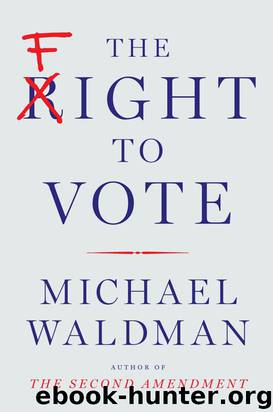1501116487 (N) by Michael Waldman

Author:Michael Waldman
Language: eng
Format: azw3, epub, mobi
Publisher: Simon & Schuster
Published: 0101-01-01T00:00:00+00:00
* * *
I. Kavanaugh is considered a strong possibility for a Supreme Court appointment someday. (He wrote much of Kenneth Starr’s report on the Monica Lewinsky scandal. His defenders insist that he was responsible only for the G-rated sections.)
13
Five to Four
STARTING IN 2010 the U.S. Supreme Court, led by Chief Justice John Roberts, issued a series of dramatic rulings that struck down long-standing laws of democracy. Its rulings on voting, campaign money, redistricting, and other matters significantly reshaped the terrain on which these issues are fought.
Of course courts have always played a part in the fight over democracy in America—but frequently a bit part. Despite Tocqueville’s observation, “There is almost no political question in the United States that does not sooner or later resolve itself into a judicial question,” the shape of democracy in America, for most of its history, has not been a judicial question. Courts have found varying ways to avoid “political questions,” “political rights,” and the “political thicket.”
But in the 1950s and 1960s courts became increasingly involved. Judges helped break long-standing and widely recognized barriers to effective representation, through means such as the “one person, one vote” rulings. Judges have been called on to adjudicate election rules, everything from how “provisional ballots” are counted to the appropriate number of days for early voting. And in the 1980s and 1990s they helped greatly expand the number of minorities in office with a second generation of Voting Rights Act cases that undid electoral systems that had diluted minority voting power. In Thornburgh v. Gingles in 1986 the Supreme Court unanimously voided North Carolina’s use of multimember districts that had made it all but impossible for black voters to elect their preferred candidates in the face of white bloc voting. The Court went on to strike down at-large elections and other Progressive Era schemes that had made it harder for communities to achieve representation. In their place, the justices ordered the creation of majority-minority districts. Over time, voting rights law would become mired in acronyms and technical formulas, revolving around tests of “bivariate regression analyses” and “vote dilution” and “disparate impact.” Over the course of four decades the Court stayed involved, but when it came to the law of democracy it rarely made sudden or transformative moves as it had during the Warren era—and as it would under John Roberts.
The current Court’s activist conservatism is hardly news, though it has mostly moved cautiously. The 2008 decision in District of Columbia v. Heller announcing an individual right to gun ownership under the Second Amendment made clear that strong gun laws were still “presumptively constitutional.” And Justice Roberts voted with the majority to uphold the Affordable Care Act in 2012 under the Constitution’s “taxing power.” But the Court’s aggressive moves to strike down laws that try to expand democratic rights are unprecedented.
Jeffrey Toobin, a New Yorker correspondent, made a telling point after one such ruling: “Every Chief Justice takes on a project. Earl Warren wanted to desegregate the South. Warren Burger wanted to limit the rights of criminal suspects.
Download
1501116487 (N) by Michael Waldman.epub
1501116487 (N) by Michael Waldman.mobi
This site does not store any files on its server. We only index and link to content provided by other sites. Please contact the content providers to delete copyright contents if any and email us, we'll remove relevant links or contents immediately.
| Automotive | Engineering |
| Transportation |
Whiskies Galore by Ian Buxton(41720)
Introduction to Aircraft Design (Cambridge Aerospace Series) by John P. Fielding(33017)
Small Unmanned Fixed-wing Aircraft Design by Andrew J. Keane Andras Sobester James P. Scanlan & András Sóbester & James P. Scanlan(32685)
Craft Beer for the Homebrewer by Michael Agnew(18082)
Turbulence by E. J. Noyes(7895)
The Complete Stick Figure Physics Tutorials by Allen Sarah(7266)
Kaplan MCAT General Chemistry Review by Kaplan(6823)
The Thirst by Nesbo Jo(6759)
Bad Blood by John Carreyrou(6477)
Modelling of Convective Heat and Mass Transfer in Rotating Flows by Igor V. Shevchuk(6354)
Learning SQL by Alan Beaulieu(6160)
Weapons of Math Destruction by Cathy O'Neil(6085)
Man-made Catastrophes and Risk Information Concealment by Dmitry Chernov & Didier Sornette(5878)
Digital Minimalism by Cal Newport;(5588)
Life 3.0: Being Human in the Age of Artificial Intelligence by Tegmark Max(5405)
iGen by Jean M. Twenge(5326)
Secrets of Antigravity Propulsion: Tesla, UFOs, and Classified Aerospace Technology by Ph.D. Paul A. Laviolette(5238)
Design of Trajectory Optimization Approach for Space Maneuver Vehicle Skip Entry Problems by Runqi Chai & Al Savvaris & Antonios Tsourdos & Senchun Chai(4957)
Electronic Devices & Circuits by Jacob Millman & Christos C. Halkias(4866)
